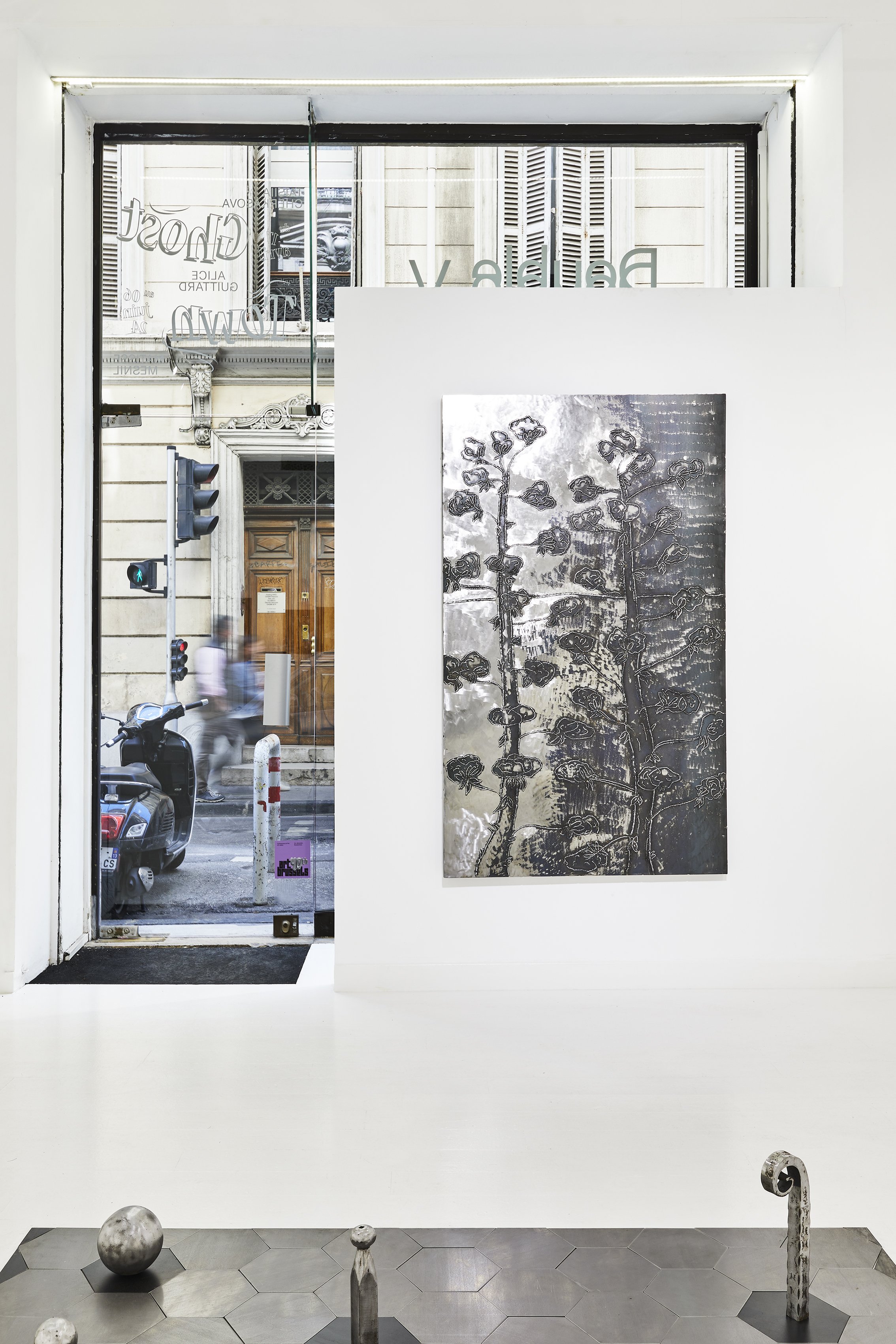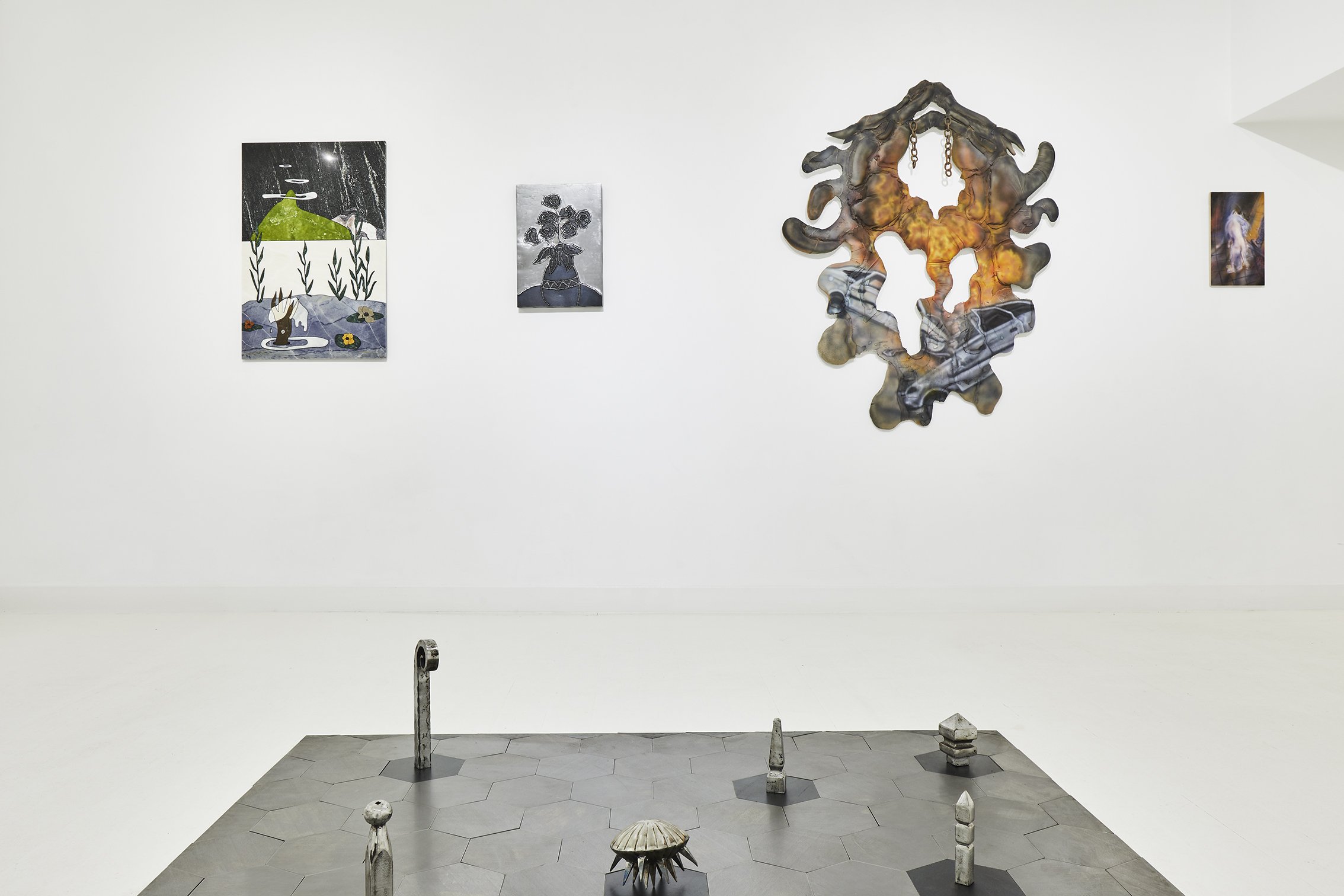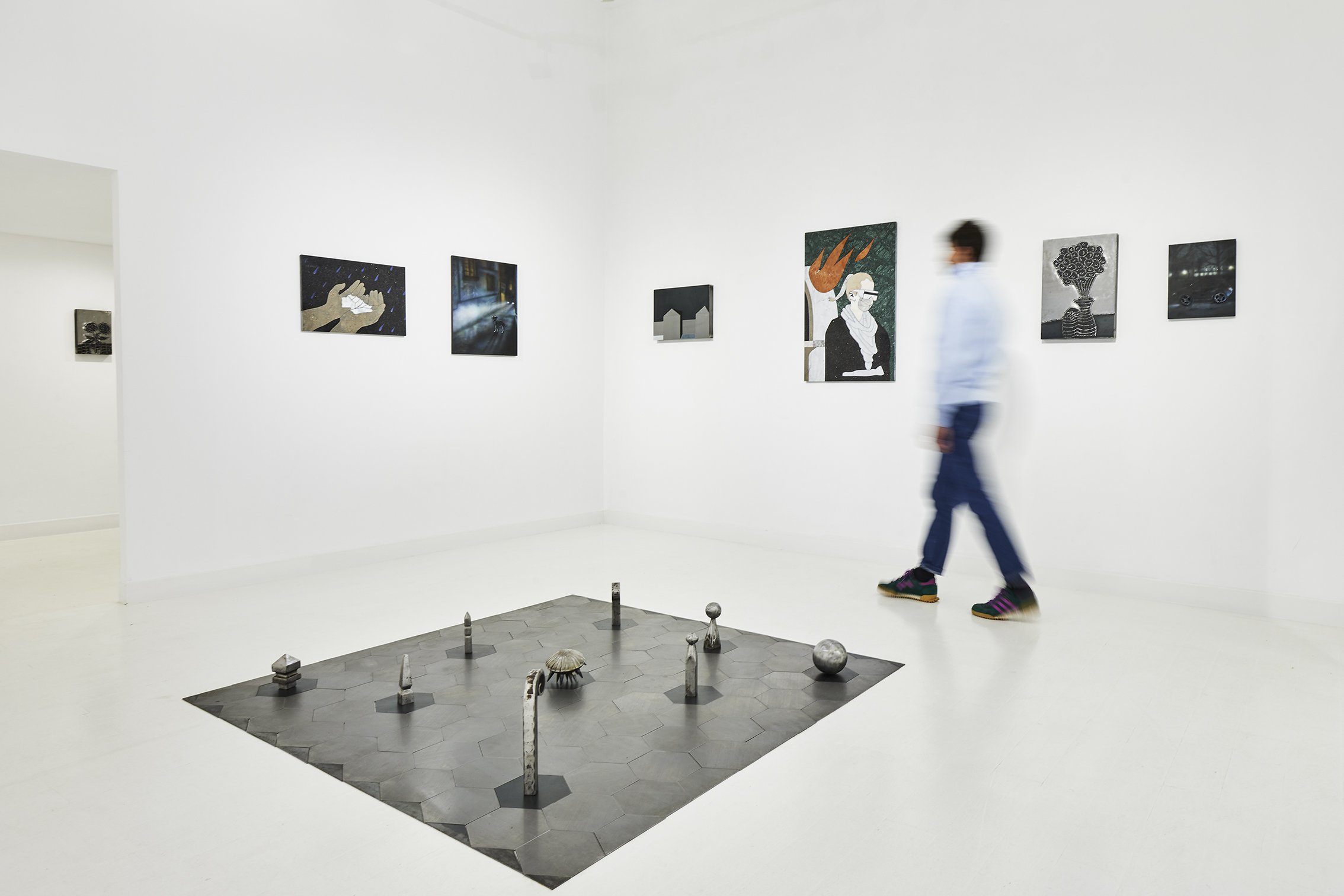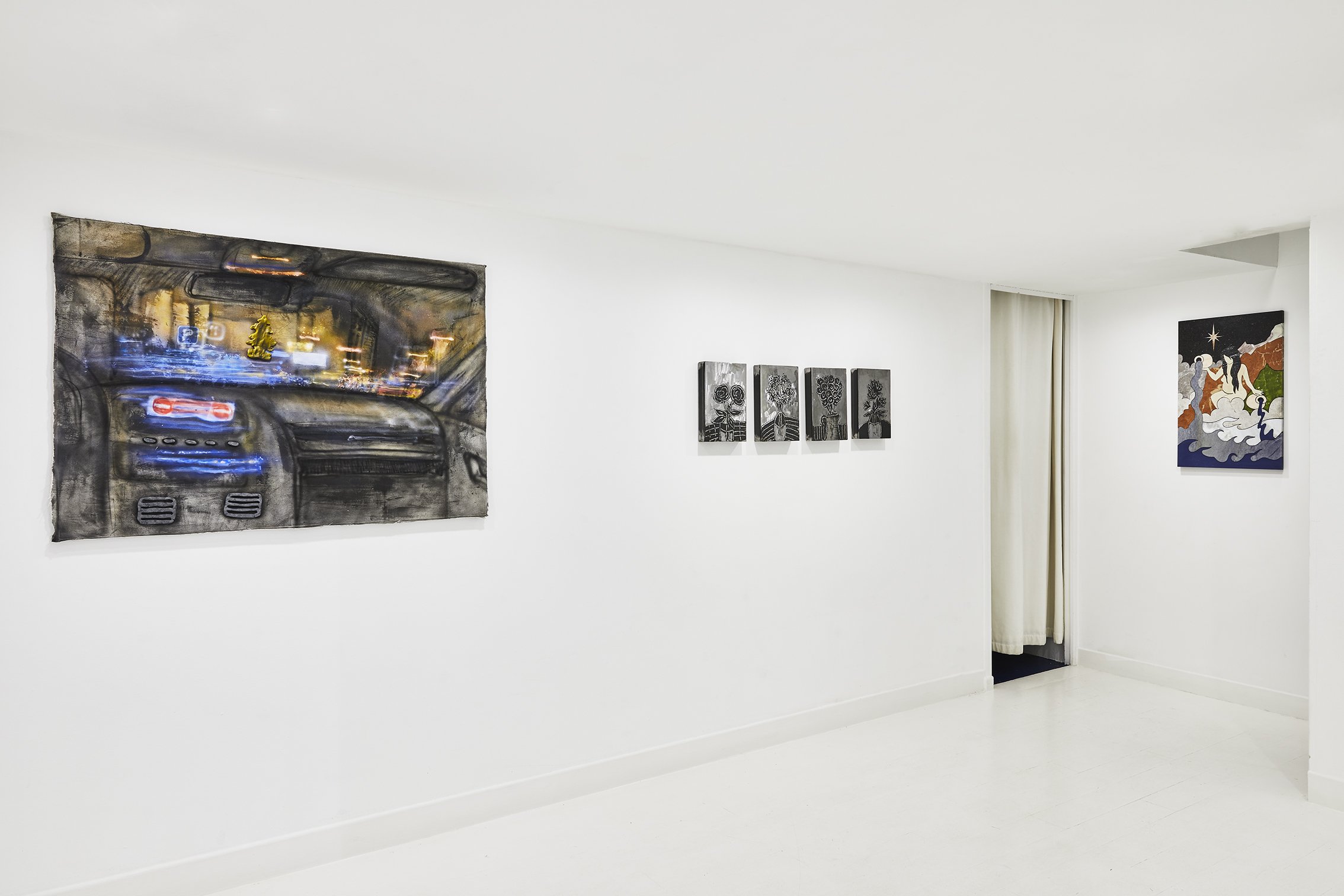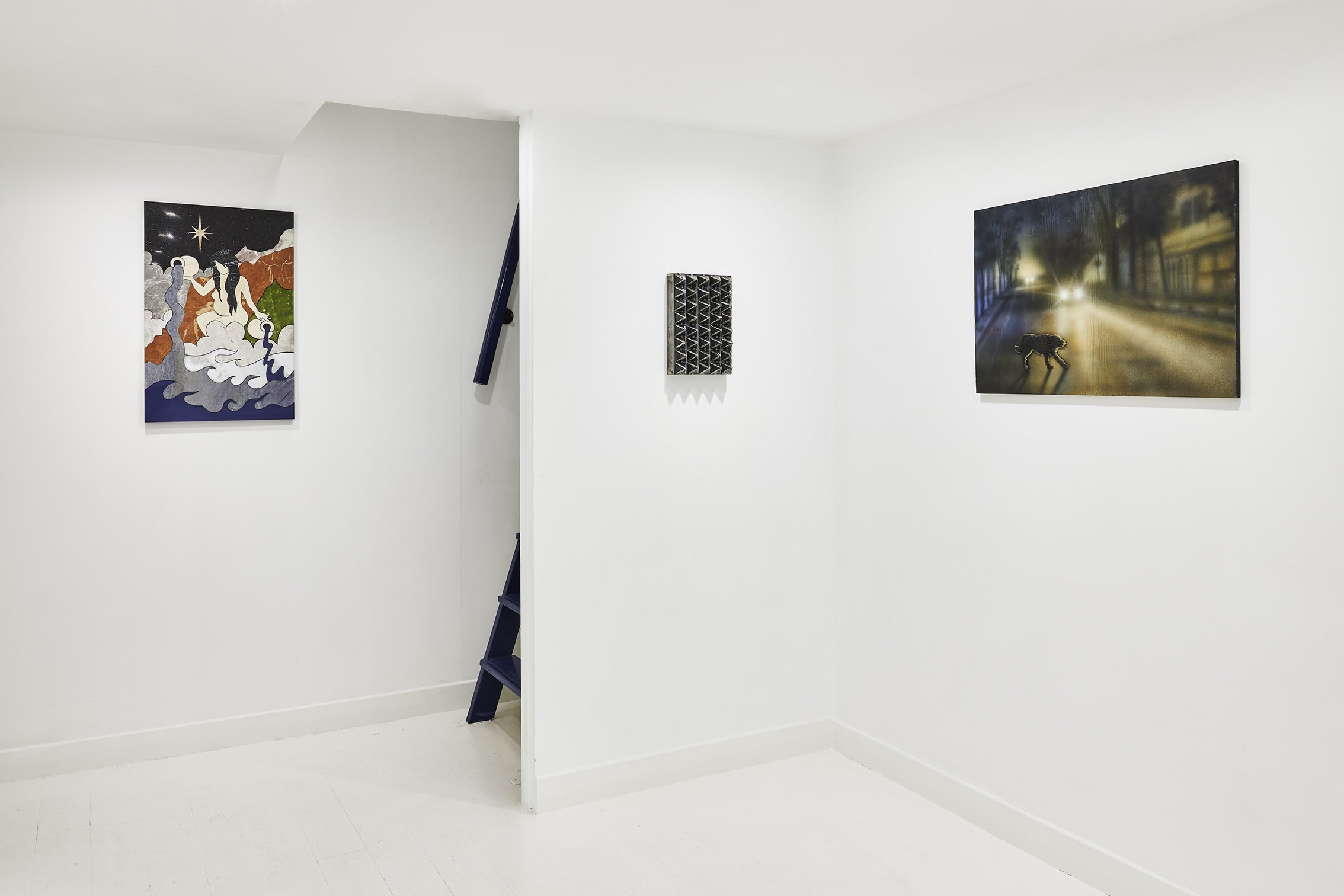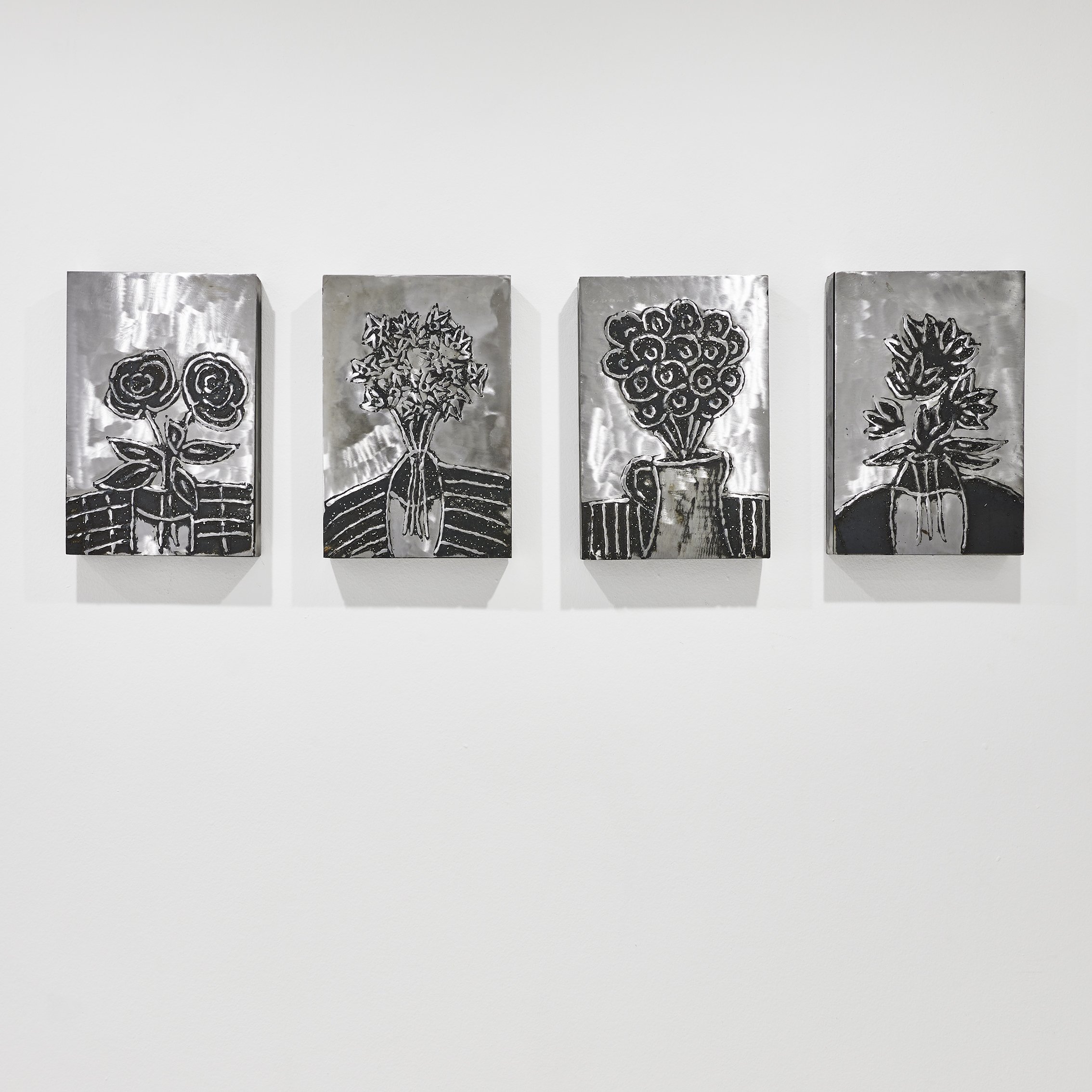Ghost town
ALICE GUITTARD - MATISSE MESNIL - TAISIIA CHERKASOVA
La galerie est heureuse de présenter l’exposition Ghost Town qui réunit pour la première fois le travail de Alice Guittard, Matisse Mesnil et de Taisiia Cherkasova.
Alice Guittard
Née en 1986 à Nice (France), Alice Guittard vit et travaille à Paris et à Lisbonne. « Alice Guittard commence à s’immerger dans la marqueterie en 2018, alors qu’elle voyageait en Turquie pour un projet d’exposition. À son arrivée à l’aéroport, la douane d’Istanbul lui demanda de détruire les produits chimiques qu’elle utilisait pour ses photos. Dans ces conditions, comment continuer à produire des images, comment fixer un monde de détails et de souvenirs pour cette artiste qui mélange sans cesse sa vie et son œuvre ? C’est en visitant les palais ottomans composés de nombreuses marqueteries qu’elle commence à se former avec un marbrier afin de continuer de travailler l’image et la pierre. Depuis, Alice Guittard n’a de cesse d’explorer la richesse infinie des textures veineuses que lui offrent le marbre. » Gaël Charbau. La question de la représentation des choses à travers l’histoire, celle de l’âme des objets et celle de nos propres souvenirs sont ainsi au cœur de la démarche d’Alice Guittard aujourd’hui. Après avoir obtenu son diplôme à la villa Arson - école des Beaux Arts de Nice - en 2013, l’artiste est remarquée à la Bourse Révélations Emerige en 2017, et a exposé depuis dans plusieurs institutions internationales (Musée des Arts Décoratifs de La Havane, Institut Culturel International de Venise...). Son travail figure, entre autres, dans la collection Laurent Dumas à Paris, de la famille Niarchos en Grèce, et dans celle de la Fondation Thalie à Bruxelles.
Matisse Mesnil
Né en 1989 à Castiglion Fiorentino (Italie), Matisse Mesnil vit et travaille à Paris. « Le travail de Matisse travail prend la forme d’une recherche : d’abord attaché à une remise en cause du paradigme albertien de la peinture, qui décrit cette dernière comme une fenêtre sur le monde, Matisse Mesnil a entrepris de déborder l'œuvre pour se concentrer sur le cadre. Il a donc engagé une phase d’expérimentation technique et méthodologique propre à son nouveau matériau de prédilection, le métal. Entre artisanat et industrie, celui-ci suppose un ajustement du geste, de la temporalité, des outils. Cette phase d’expérimentation a induit une lente dérivation, comme un retour vers la voie royale de la pratique artistique : la figuration. Le travail sur le cadre et les marges, qui évidait l’œuvre et ne laissait qu’une image vaporeuse, amovible, a produit, au fil de la pratique, le retour de la représentation. Matisse Mesnil, avec des techniques industrielles comme la soudure ou l’affûtage à la meuleuse, rejoue les moyens de la figuration, dans ses genres les plus usités, comme le paysage ou la nature morte. Au monde bruyant de l’industrie est ainsi adossée l’éthique et l’esthétique de la contemplation silencieuse qui traverse l’histoire du paysage. Une violence sourde sous-tend ses dernières pièces, qui pourtant appellent à une forme de religiosité que l’on doit aussi lire dans l’exigence scénographique et architecturale qui gouverne son travail : les œuvres de Matisse Mesnil, depuis leur format jusqu’à leur mode de monstration, sont faites pour être abordées dans l’espace et à la mesure de leurs spectateurs. » Guillaume Blanc-Marianne.
Le travail de Matisse Mesnil figure, entre autres, dans la Collection Yvon Lambert à Avignon, actuellement présentée au Mucem dans le cadre de l’exposition ‘‘Passions partagées’’.
Taisiia Cherkasova
Née en 1991 à Dnipro (Ukraine), Taisiia Cherkasova vit et travaille à Paris. « À travers ses productions mêlant peinture, céramique et textile, l’artiste cherche à traduire des sentiments et des souvenirs propres à son histoire et à ses origines. Peinte avec la distance que permet l’aérographe, son œuvre est floue car son intention réside dans la capture brumeuse d’un moment, déjà à moitié effacé. Elle permet de décoder une partie du travail de Taisiia Cherkasova, par son message mais aussi par son existence physique qui est le résultat de deux gestes simultanés : l’un radical, à travers la découpe et le travail du contour, et l’autre pudique et évocateur de l’application de matière. L’artiste n’est jamais uniquement dans la toile mais dans l’objet. Son action de décadrage contribue à la fois à accentuer la fatalité des souvenirs qu’on ne pourra jamais entièrement restituer et à leur redonner une épaisseur et une matérialité. Elle parvient également grâce à cette déconstruction à hybrider les styles et à rendre ainsi chaque pièce unique et profondément expérimentale. La tendresse de Cherkasova est bien présente mais elle opère en terre aride. Le traitement gratuit, non filtré, non analytique qu’elle fait de la violence choque et envahit les esprits de celles et ceux qui découvrent son oeuvre, aux dépends des multiples autres facettes de son travail. Ce choc qu’elle provoque est précisément là où réside l’enjeu de son œuvre : elle ne cherche pas à opérer un contrôle ou un jugement moral sur la réalité et nous pousse ainsi à décentrer nos regards. Chienne, elle démontre que le lâcher-prise et la sauvagerie ne sont pas à craindre, au contraire. Ils sont une nouvelle forme, furieuse, de salvation. Une manière d’être ‘still a life’. » Justine Daquin
~
The gallery is delighted to present the exhibition Ghost Town, bringing together for the first time the works of Alice Guittard, Matisse Mesnil, and Taisiia Cherkasova.
Alice Guittard
Born in 1986 in Nice (France), Alice Guittard lives and works in Paris and in Lisbon. « Alice Guittard began to immerse herself in the art of marquetry in 2018 during a trip to Turkey for an exhibition project. Upon arriving at the airport, Istanbul customs officers insisted she destroy the chemical products she used for her photographs. As an artist who constantly mixes her work with her life, this situation raised immediate questions of how she would continue to produce images, how she would capture a world rich in details and memories? Her visits to Ottoman palaces with their marquetry and inlaid works inspired her to begin training with a marble worker so she could create with images and stone. Since that moment, Alice Guittard has never ceased exploring the infinite wealth that the veined textures of marble offer to her. » Gaël Charbau. The questioning of the representation of things throughout history, of the soul of objects, and of our own memories is at the very heart of Alice Guittard’s approach today. After graduating from the Villa Arson – Ecole des Beaux-Arts in Nice in 2013, the artist was noticed through the Bourse Révélations Emerige program in 2017 and has since been exhibited at several international institutions (the National Museum of Decorative Arts in Havana, the ICI International Cultural Institute in Venice...). Her work is part of numerous important collections, including the Collection Laurent Dumas in Paris, the Niarchos family collection in Greece, and the Fondation Thalie collection in Brussels.
Matisse Mesnil
Born in 1989 in Castiglion Fiorentino (Italy), Matisse Mesnil lives and works in Paris. « Matisse’s work takes the form of a research: initially tied to a questioning of the Albertian paradigm of painting, which describes it as a window onto the world, Matisse Mesnil set out to transcend the artwork to focus on the frame. He thus embarked on a phase of technical and methodological experimentation specific to his new preferred material, metal. Between craftsmanship and industry, this entails an adjustment of gesture, temporality, and tools. This phase of experimentation led to a slow deviation, akin to a return to the royal path of artistic practice: figuration. The work on the frame and margins, which hollowed out the artwork and left only a hazy, removable image, resulted, through practice, in the resurgence of representation. Matisse Mesnil, employing industrial techniques such as welding or grinding, reenacts the means of figuration in its most common genres, such as landscape or still life. The noisy world of industry is thus juxtaposed with the ethics and aesthetics of silent contemplation that runs through the history of landscape. A muted violence underlies his recent pieces, which nonetheless call for a form of religiosity that can also be discerned in the scenographic and architectural demands governing his work: Matisse Mesnil’s works, from their format to their mode of presentation, are designed to be approached in space and tailored to their viewers. » Guillaume Blanc-Marianne.
Matisse Mesnil’s work is featured, among others, in the Yvon Lambert Collection in Avignon, currently on display at the Mucem as part of the exhibition ‘‘Passions partagées’’.
Taisiia Cherkasova
Born in 1991 in Dnipro (Ukraine), Taisiia Cherkasova lives and works in Paris. « Through her productions blending painting, ceramics, and textiles, the artist seeks to translate feelings and memories unique to her history and origins. Painted with the detachment afforded by the airbrush, her work is blurry because her intention lies in the misty capture of a moment, already halfway erased. It helps decode a portion of Taisiia Cherkasova’s work, both through its message and its physical existence, which is the result of two simultaneous gestures: one radical, through cutting and contour work, and the other modest and evocative through the application of material. The artist is never solely in the canvas but in the object. Her action of decentering contributes both to accentuating the inevitability of memories that can never be fully restored and to giving them thickness and materiality. Through this deconstruction, she also manages to hybridize styles, thus rendering each piece unique and profoundly experimental. Cherkasova’s tenderness is indeed present, but it operates in arid soil. The gratuitous, unfiltered, non-analytical treatment she gives to violence shocks and invades the minds of those who discover her work, at the expense of the many other facets of her work. This shock she provokes is precisely where the challenge of her work lies: she does not seek to exert control or moral judgment on reality, thus pushing us to shift our perspectives. Boldly, she demonstrates that letting go and savagery are not to be feared; on the contrary, they represent a new, furious form of salvation. A way of being ‘still a life’. » Justine Daquin


